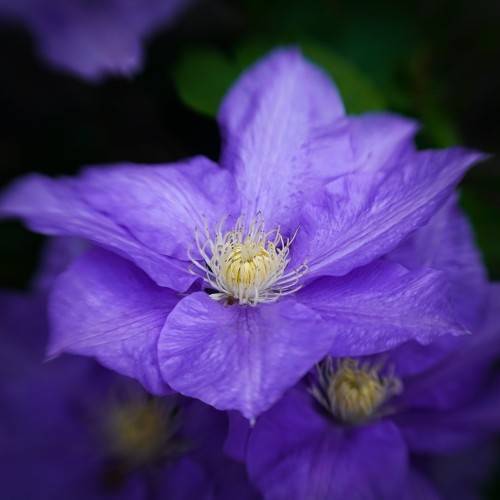
clematis
Clematis 'Jackmanii Superba'
Cycle:
Perennial
Watering:
Average
Hardiness Zone:
4 - 8
Flowers:
Flowers
Sun:
Full sun,part shade
Leaf:
Yes
Growth Rate:
High
Maintenance:
Low
Care Level:
Medium
watering
When watering a Clematis 'Jackmanii Superba', it is important to ensure the soil remains moist but not soggy. To do this, water the plant deeply but infrequently. Water early in the morning 2 to 3 times a week for the first few weeks, and then move to once a week. If temperatures are particularly hot, warm, or dry, increase the frequency of watering. Ensure that the soil never dries out completely, as this could cause root damage. While the plant is actively growing, reduce the frequency of watering or stop altogether to help promote flowering. The plant should then be watered again every few weeks once the growth has slowed.
sunlight
Clematis 'Jackmanii Superba' prefers a spot in full sun or light shade. The plant will do best if it receives at least 8 hours of direct sunlight each day, preferably during the morning through midday so that the evening light is more gentle and the plant begins to cool down in preparation for the nighttime. If in shade, make sure that the plant still has access to bright, indirect sunlight for at least 4-5 hours each day. Although it can tolerate lower-light conditions, the plant may not reach its full potential and may not flower as fully as those grown in full sun.
pruning
When it comes to pruning your Clematis 'Jackmanii Superba', the best time to do so is in late winter or early spring, before the plant has fully emerged from dormancy. It is important to prune lightly and not cut too much away as this can weaken the plant. Start by cutting away any dead or damaged stems or foliage, and then shorten the old stems to just above the previous year's bud. How much you need to prune depends upon how the Clematis is trained. For a free-standing vine, prune stems back to terminate approximately 3 to 4 feet tall. For a container-grown vine along a trellis or fence, prune back each stem to 4 to 6 buds from soil level. It should also be noted that too much or improper pruning can make the vine’s flowers sparse.
Season
Hardiness Map
FAQ
Can Clematis plants grow in pots?
Yes, Clematis plants can definitely be grown in pots. When planting a Clematis in a pot make sure to use a larger size pot with drainage holes and fill it with a mix of well-draining potting soil and compost. Ensure to keep the root area cool and the pot in a sunny location while providing regular water and fertilization. Check the plant almost daily to make sure it is not becoming too dry. Clematis can do well in a pot and with the right care and conditions, they will thrive.
Are Clematis plants self-pollinating?
No, clematis plants are not self-pollinating. Clematis plants need pollinators such as bees, butterflies, moths and other insects to transfer pollen from the male anthers to the female stigma of the flower in order to produce viable seed. Pollination must also occur within relatively close proximity of the same species in order to create viable hybrid plants.
Can Clematis plants be grown as a houseplant?
Yes, Clematis plants can be grown as a houseplant. It is best to grow them in a pot with full sun and a soil that is rich in organic material and retains moisture. When potting the plant, place a stake or trellis next to the pot so that the vine can climb when it begins to grow. Be sure to water your Clematis plant regularly to keep it healthy and growing. Additionally, keep an eye out for pests and treat with natural insecticides as necessary.
Could Clematis plants survive in a colder climate?
Yes, Clematis plants can survive in colder climates with proper preparation. If planted in the fall, proper mulching should be done to protect the roots from cold temperatures. If planted in the spring, they should be watered frequently to help them adjust to the cooler temperatures more quickly. If temperatures drop below -20°C ( -4°F), additional measures may need to be taken such as the application of protective wraps and thermal insulation. Additionally, plants in exposed areas should be protected from the wind to prevent excessive dehydration. With the right measures in place, Clematis plants can easily survive in colder climates.
Could Clematis plants be grown in a greenhouse?
Yes, clematis plants can be grown in a greenhouse. Due to their vine-like growth habit and tropical native origins, clematis plants thrive in the moist and warm environment of a greenhouse. Clematis are generally grown from cuttings or from dividing existing plants, and benefit from regular pruning and fertilizing. They will also enjoy the indirect light of a greenhouse and the protection from strong winds and temperatures that the humidity and contained environment provides.
